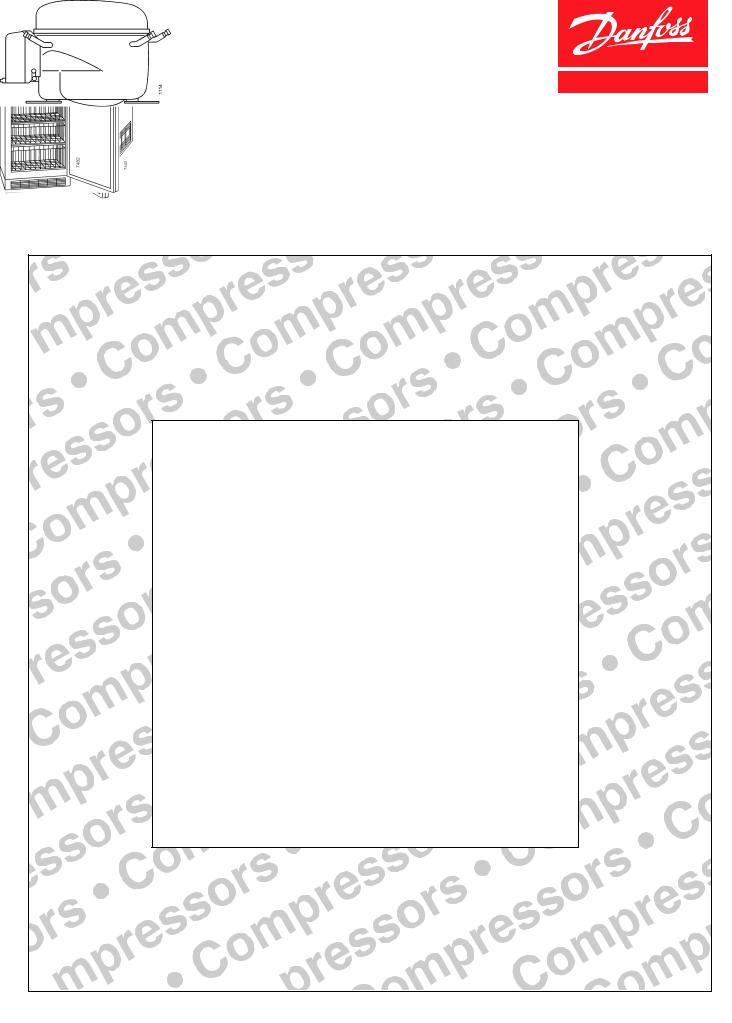Danfoss R401A, R401B, R409A, R409B, R134a Installation guide

Service on Household Refrigerators and Freezers Using New Refrigerants
Compressors
April 1996 |
CN.73.C3.02 |
1 |

|
|
|
Replaces CN.73.C2.02 |
|
|
|
|
|
|
||
1.0 Introduction |
Within a foreseeable future, CFC refrigerants will become unobtainable. This is a situation that will |
||||||||||
|
effect the service possibilities on R12 systems in household appliances. In new production of |
||||||||||
|
household appliances R12 will be replaced by R134a or R600a. |
|
|
|
|
||||||
|
Please note that this guide excludes service on commercial appliances. |
|
|
|
|||||||
1.1 Blends |
Since the introduction of R134a, several “transitional substances” have appeared. They have a |
||||||||||
(mixtures of HFC) |
low ODP number and are intended for service only. |
|
|
|
|
|
|||||
|
These refrigerants are interesting because they do not presuppose the use of polyolester oil. |
||||||||||
1.2 R134a (HFC) |
To ensure a satisfactory miscibility between refrigerant and oil, the application of R134a refrigerant |
||||||||||
|
presupposes the use of an R134a compressor charged with polyolester (POE). |
|
|
||||||||
|
This will complicate the future servicing when R12 refrigeration systems are to be changed over to |
||||||||||
|
R134a refrigerant, as it is difficult to prevent contamination by residues of the original refrigeration |
||||||||||
|
oil, typically mineral oil or alkyl benzene. |
|
|
|
|
|
|
||||
|
The presence of residual mineral oil or alkyl benzene is unfortunate because it does not become |
||||||||||
|
part of the R134a/POE mixture but circulates independently through the system. The effect can be |
||||||||||
|
negative if the system contains “oil pockets”. After some time, the oil circulating in the system can |
||||||||||
|
collect in quantities which pass through the capillary tube relatively slowly. This will effect the |
||||||||||
|
refrigerant injection into the evaporator momentarily. |
|
|
|
|
|
|||||
1.3 R600a (Hydrocarbon) |
This refrigerant is flammable and only allowed for use in appliances which fulfil the safety require- |
||||||||||
|
ments laid down in amendment TS 95006 to IEC 335 - 2 - 24 (To cover potential risk originated |
||||||||||
|
from the use of flamable refrigerants). |
|
|
|
|
|
|
||||
2.0 General |
In principle there is no need to replace the refrigerant in operational hermetic refrigeration sys- |
||||||||||
|
tems. Neither is there any point in replacing refrigerant when servicing, provided that the original |
||||||||||
|
refrigerant is available either as new or reclaimed. A precondition here is of course that the legis- |
||||||||||
|
lation of the country concerned is not restrictive in this respect. |
|
|
|
|
||||||
|
Changing over to an alternative refrigerant is not without problems. Close consideration should be |
||||||||||
|
given to the economic justification of proceeding with the task. It is also appropriate to find out just |
||||||||||
|
what the user expects in terms of the operation and lifetime of the repaired system. |
||||||||||
|
The choice of refrigerant for servicing R12 systems is between the transitional substances (blends) |
||||||||||
|
or R134a. |
|
|
|
|
|
|
|
|
|
|
|
Among the refrigerant mixtures offered are R401A and R401B which are marketed by DuPont. |
||||||||||
|
These blends are ternary mixtures (non-azeotropes) made of three single components, R22, R152a, |
||||||||||
|
and R124. Corresponding mixtures are also marketed by Atochem, R409A (Forane FX 56) and |
||||||||||
|
R409B (Forane FX57). They are based on the components R22, R142B, and R124 (table 1). The |
||||||||||
|
mixtures are interesting because they do not presuppose the use of polyolester compressor oil. |
||||||||||
|
They have a low ODP number and can be used for service when R12 refrigerant is prohibited. |
||||||||||
|
|
|
|
|
|
|
|
|
|
|
|
|
ASHRAE |
|
Components |
Composition |
|
Trade name |
ODP |
GWP |
Temp. |
Oil type |
|
|
No. |
|
|
% |
|
|
|
|
glide |
|
|
|
|
|
|
|
|
|
|
|
|
|
|
|
R401A |
|
R22 - R152a - R124 |
53 - 13 - 34 |
|
Suwa MP39 |
0.03 |
0.22 |
6.4 |
Alkyl benzene |
|
|
R401B |
|
R22 - R152a - R124 |
61 - 11 - 28 |
|
Suwa MP66 |
0.035 |
0.24 |
6.0 |
Alkyl benzene |
|
|
R409A |
|
R22 - R142B - R124 |
60 - 15 - 25 |
|
Forane FX56 |
0.05 |
0.31 |
8.1 |
Alkyl benzene |
|
|
R409B |
|
R22 - R142B - R124 |
65 - 10 - 25 |
|
Forane FX57 |
0.05 |
0.31 |
7.2 |
Alkyl benzene |
|
|
R134a |
|
|
|
|
|
0.0 |
0.28 |
0.0 |
Ester oil |
|
Table 1. Refrigerants for servicing R12 systems
2 |
CN.73.C3.02 |
April 1996 |

2.1 Servicing with blends The blends mentioned can be used for servicing, provided the following rules are observed,
The original compressor can be used, provided that it is intact. But the compressor oil must be of the type alkyl benzene.
If the original compressor contains mineral oil it has to be changed to alkyl benzene. The alkyl benzene must have more or less the same viscosity as the original oil.
A viscosity of about 30 cSt is a suitable choice for household refrigeration compressors.
Table 2 shows the oil types used in Danfoss compressors.
Compressor type |
Voltage |
Compressor |
Present oil type |
Oil type for blend |
|
|
|
displacement |
|
|
|
|
V |
cm3 |
|
|
|
|
|
|
|
|
|
TL-A |
115 |
2 |
- 4 |
Synthetic |
Unchanged |
|
|
|
|
|
|
TL-A |
220 |
2 |
- 4 |
Mineral |
Alkyl benzene |
|
|
|
|
|
|
TL-A |
220 |
|
5 |
Synthetic |
Unchanged |
|
|
|
|
|
|
TLS-A |
220 |
|
4 |
Mineral |
Alkyl benzene |
TLS-A |
220 |
|
5 |
Synthetic |
Unchanged |
|
|
|
|
|
|
TLES-A |
220 |
|
4 |
Mineral |
Alkyl benzene |
|
|
|
|
|
|
TLES-A |
220 |
|
5 |
Synthetic |
Unchanged |
|
|
|
|
|
|
TFS-A |
115 |
4 |
- 5 |
Synthetic |
Unchanged |
|
|
|
|
|
|
TFS-AT |
220 |
4 |
- 5 |
Synthetic |
Unchanged |
TF-B |
115 |
|
4 |
Synthetic |
Unchanged |
TL-B |
220 |
2.5 - 3 |
Mineral |
Alkyl benzene |
|
|
|
|
|
|
|
TL-B |
220 |
|
4 |
Synthetic |
Alkyl benzene |
|
|
|
|
|
|
NLE-A |
115 |
6 |
- 7 |
Synthetic |
Unchanged |
|
|
|
|
|
|
NF-A |
115 |
|
6 |
Synthetic |
Unchanged |
|
|
|
|
|
|
NL-A |
220 |
6 |
- 7 |
Mineral |
Alkyl benzene |
|
|
|
|
|
|
NLE-A |
230 |
6 |
- 7 |
Mineral |
Alkyl benzene |
|
|
|
|
|
|
FR-A |
115 |
7.5 |
- 8.5 |
Mineral |
Alkyl benzene |
|
|
|
|
|
|
FR-A |
220 |
7.5 - 10 |
Mineral |
Alkyl benzene |
|
|
|
|
|
|
|
FR-A |
220 |
11 |
V-Oil 7041 |
Unchanged |
|
|
|
|
|
|
|
FF-AT |
220 |
6 - 10 |
Mineral |
Alkyl benzene |
|
|
|
|
|
|
|
FFS-A |
115 |
7 |
- 9 |
Mineral |
Alkyl benzene |
|
|
|
|
|
|
FF-BK |
115 |
6.5 |
- 8.5 |
Mineral |
Alkyl benzene |
|
|
|
|
|
|
FF-BX |
115 |
6.5 |
- 8.5 |
Mineral |
Alkyl benzene |
FR-B |
220 |
6 - 11 |
Mineral |
Alkyl benzene |
|
|
|
|
|
|
|
FR-H |
220 |
|
7 |
V-Oil 7041 |
Unchanged |
|
|
|
|
|
|
SC-A |
115 |
12 |
- 15 |
Mineral |
Alkyl benzene |
|
|
|
|
|
|
SC-A |
220 |
12 |
- 15 |
Mineral |
Alkyl benzene |
SC-A |
220 |
18 |
- 21 |
V-Oil 7041 |
Unchanged |
SC-AA |
240 |
15 |
V-Oil 7041 |
Unchanged |
|
|
|
|
|
|
|
SC-B |
115/220 |
10 |
- 21 |
V-Oil 7041 |
Unchanged |
SC-H |
220 |
10 |
- 15 |
V-Oil 7041 |
Unchanged |
|
|
|
|
|
|
SC-HH |
220 |
10 |
- 15 |
V-Oil 7041 |
Unchanged |
Table 2. Oil types
If the original compressor is defective, the choice is between an R12 compressor and an R134a compressor. The refrigeration capacity should be about the same as that of the original compressor. The R12 compressor oil must be changed over to alkyl benzene oil, provided that the original oil charge was mineral oil. The R134a compressor can be used directly charged with polyolester oil.
The filter drier must always be replaced. The new filter drier must contain a desiccant of the type XH9 (UOP) or Siliporite H3R (CECA)
The system components, especially the evaporator, will always contain some oil transferred from the original compressor. This is not critical if the new compressor contains alkyl benzene. But if a compressor containing polyolester is to be used, residues in the original oil must be kept to the lowest possible.
April 1996 |
CN.73.C3.02 |
3 |
